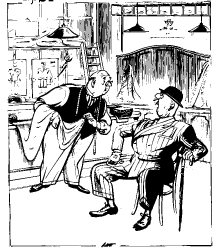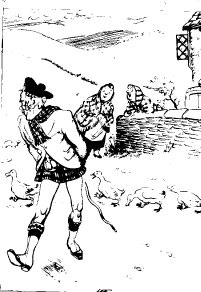|
|
|
|
The fishermen are saving lives
Ministry of Food advertisement, 1940 .
|
Going DeeperPeople at War - BBC1 An extract from Norman Longmate's fantastic book: How We Lived Then
Memories of rationing
|
|
A week's rations for one adult
|
|
Ration Books
So rationing was introduced. People got a ration book full of coupons which allowed them to buy just a limited amount. Petrol was rationed after September 1939. Butter, sugar, bacon, paper and meat were rationed from early 1940. By the end of the war, half Britain's food was rationed. You needed ration coupons to buy clothes after June 1941. People saved up their coupons to buy things such as lard (to make pastry). Children saved their sweet rations, or bought cheap sweets that would last a long time (eg hundreds and thousands). It was a disaster to lose your ration book. One side effect of rationing was a flourishing 'black market' where people could buy things, secretly, off ration at high prices. The second effect of rationing and price control was that - by the end of the war - the poor people of Britain had never been so healthy! There was much less, but it had been shared out far more fairly. This was one of the key facts that led to the creation of the Welfare State after the war.
|
Source AWartime was difficult for housewives. Nobody starved but food was dull. Nobody grew fat but nobody starved. Fiona Reynoldson, War at Home (1980)
|
Grow Your Own
● Farmers were encouraged to plough up as much land as they could. ● The Women's Land Army was mobilised to provide workers in place of farm workers who had been called up. ● Public parks, bomb sites and railway embankments were used as allotments. ● Householders were told to use their gardens to grow vegetables, and many people kept rabbits and chickens. ● People formed Pig Clubs, and shared the meat when the pig was slaughtered. Food waste was collected in pig bins to feed to the pigs.
In 1940 the government set up the Ministry of Food, under Lord Woolton. It issued information to try to help people accept the food shortages. This included: ● a morning radio programme (The Kitchen Front) gave housewives recipes on how, for instance, to make a 'tasty' dessert out of potatoes, without flour, sugar or lard. One government tip was use liquid paraffin (a laxative) instead of lard in baking - the effects were devastating! ● Lord Woolton spoke on the radio. He was cheerful and treated housewives like he was speaking to his daughters. He told them what food was good for them and their families; many people trusted him and liked him. ● propaganda, such as jolly adverts in newspaper, bright posters and catchy phrases and rhymes - 'the sight of potato peelings, hurts Lord Woolton's feelings'. Cartoon characters - 'Potato Pete' and 'Dr Carrot' - were used to encourage people to eat more foods that were not rationed. ● the government encouraged people to use alternatives wherever possible - they used SPAM instead of ham, and British flour (which was poor quality and grey) instead of American flour (which was white).
|
Source BBread wasted Bristol Evening Post (20 January 1943).
|
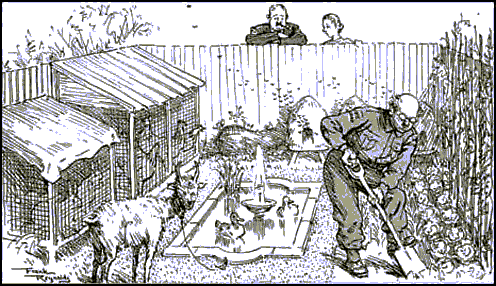
|
← Source CThis 1943 cartoon shows a patriotic householder. How many different things can you spot him doing to help the 'Grow Your Own' campaign? How else has he been helping the war effort? |
Make do and Mend
● In July 1940 it held a metal collection - supposedly to make airplanes. The aircraft factories were not short of metal, but the government wanted people to feel that they were 'doing their bit'. ● The Women's Voluntary Service and a children's club called COGS collected things house-to-house like bottle tops, old iron, paper, wool and bones (used to make explosives and fertiliser). The COGS children had an anthem 'There'll always be a dustbin' which was sung to the tune of 'There'll always be an England'. ● People gave their pots and pans, cut off their iron railings, threw out their sewing machines etc. Many people offered their false legs (which were made from high-quality aluminium) to make airplanes. ● To save cloth, the government passed laws forbidding men's clothes to be made with turn-ups, wide lapels or double-breasted. Women's skirts were made straight and shorter. These clothes were labelled with a government 'utility mark', and were therefore known as utility clothing. (There was also simple, 'utility furniture'.) ● The government set up clothes swapshops, where you could take old clothes and take away new ones. They were especially popular with poor people with growing children. It became fashionable to wear simple and old-fashioned clothes, to show you were 'doing your bit' for the war effort - these were called the 'austerity' (= time of shortage) fashions. ● The government ran a campaign to try to persuade people to use only 6 inches (15 cm) of water in their baths, to try to save on the coal needed to heat it up. ● The Board of Trade issud posters encourging people to patch their clothes, and take care of their clothes, and shoes.
|
Source D
In this cartoon of 25 March 1942, the rich man says: '"No double-breast? No pleats? No turn-ups? Dammit man, what d'y 'think I am - a nudist?
|
Source E
In this cartoon of 31 March 1942, the women are saying: "Aye! It takes a brave laddie to look well i' the new austerity kilts."
|
Consider:Study Sources D and E. Use your knowledge of Rationing in World War II to explain the humour in the cartoons.
|
|
|
|
|
Spotted an error on this page? Broken link? Anything missing? Let me know. |
|

 In 1939 Britain only grew enough food to feed one person in every three - Nazi U-boats threatened to starve the country into defeat. But it was not just food - Britain brought many other things from abroad (notably sugar, tea, fruit, oil, rubber and wood) and now all these supplies were threatened by the U-boat attacks. The government needed to control the supply of many things that were going to be in short supply.
It could not risk the public anger if there were shortages, and prices went up,
and only the rich could afford things.
In 1939 Britain only grew enough food to feed one person in every three - Nazi U-boats threatened to starve the country into defeat. But it was not just food - Britain brought many other things from abroad (notably sugar, tea, fruit, oil, rubber and wood) and now all these supplies were threatened by the U-boat attacks. The government needed to control the supply of many things that were going to be in short supply.
It could not risk the public anger if there were shortages, and prices went up,
and only the rich could afford things.
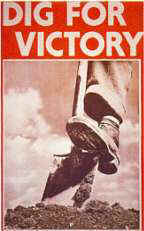 The
government set up a 'Grow Your Own' campaign.
The
government set up a 'Grow Your Own' campaign.
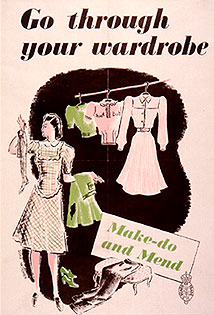 The government encouraged recycling and salvage to try to make the most efficient use of resources:
The government encouraged recycling and salvage to try to make the most efficient use of resources:
